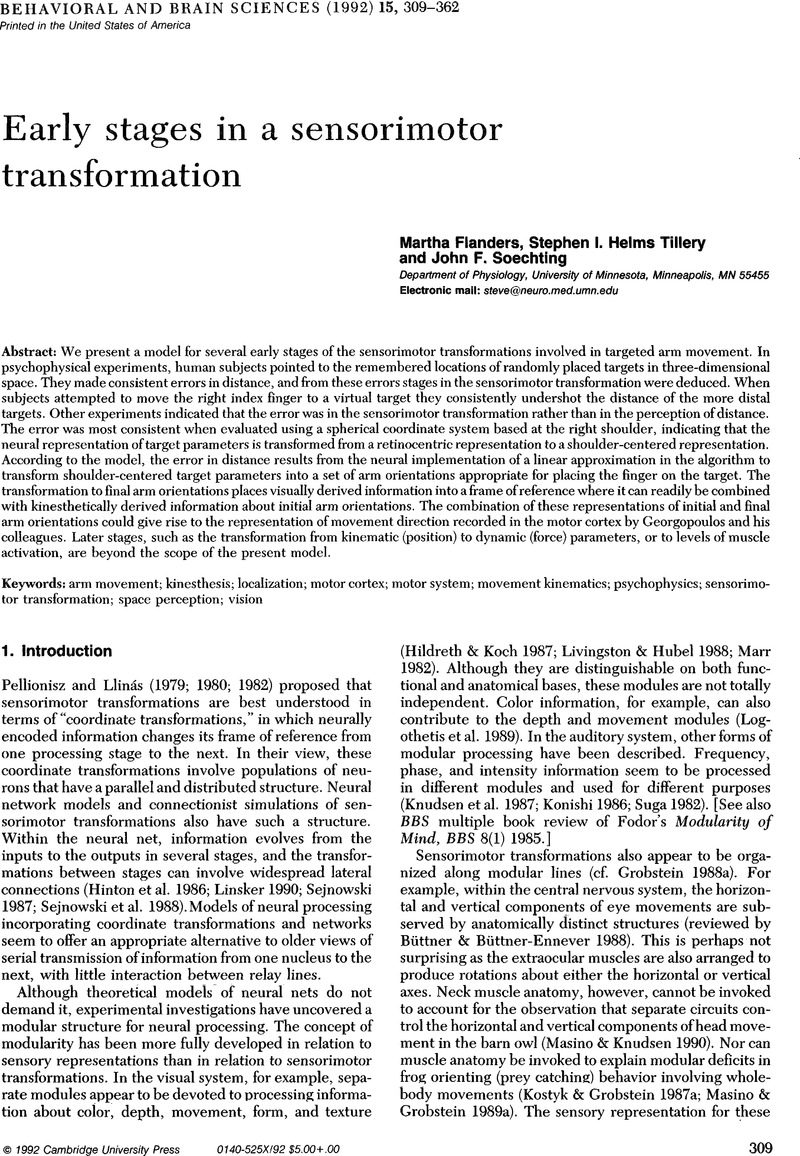Crossref Citations
This article has been cited by the following publications. This list is generated based on data provided by Crossref.
Leiner, Henrietta C.
Leiner, Alan L.
and
Dow, Robert S.
1993.
Cognitive and language functions of the human cerebellum.
Trends in Neurosciences,
Vol. 16,
Issue. 11,
p.
444.
Bracha, Vlastislav
Webster, Michelle L.
Winters, Noël K.
Irwin, Kristina B.
and
Bloedel, James R.
1994.
Effects of muscimol inactivation of the cerebellar interposed-dentate nuclear complex on the performance of the nictitating membrane response in the rabbit.
Experimental Brain Research,
Vol. 100,
Issue. 3,
p.
453.
Ada, L.
Canning, C.G.
Carr, J.H.
Kilbreath, S.L.
and
Shepherd, R.B.
1994.
Vol. 105,
Issue. ,
p.
239.
De Schutter, Erik
1995.
Cerebellar long-term depression might normalize excitation of Purkinje cells: a hypothesis.
Trends in Neurosciences,
Vol. 18,
Issue. 7,
p.
291.
Windhorst, U.
1996.
Comprehensive Human Physiology.
p.
1033.
van Brakel, J.
1996.
Interdiscourse or supervenience relations: The primacy of the manifest image.
Synthese,
Vol. 106,
Issue. 2,
p.
253.
Milak, M. S.
Shimansky, Y.
Bracha, V.
and
Bloedel, J. R.
1997.
Effects of Inactivating Individual Cerebellar Nuclei on the Performance and Retention of an Operantly Conditioned Forelimb Movement.
Journal of Neurophysiology,
Vol. 78,
Issue. 2,
p.
939.
D’Angelo, Egidio
1997.
Human and Machine Perception.
p.
109.
Jueptner, M.
Frith, C. D.
Brooks, D. J.
Frackowiak, R.S.J.
and
Passingham, R. E.
1997.
Anatomy of Motor Learning. II. Subcortical Structures and Learning by Trial and Error.
Journal of Neurophysiology,
Vol. 77,
Issue. 3,
p.
1325.
Kenyon, Garrett T.
1997.
A model of long-term memory storage in the cerebellar cortex: A possible role for plasticity at parallel fiber synapses onto stellate/basket interneurons.
Proceedings of the National Academy of Sciences,
Vol. 94,
Issue. 25,
p.
14200.
Katz, D B
and
Steinmetz, J E
1997.
Single-unit evidence for eye-blink conditioning in cerebellar cortex is altered, but not eliminated, by interpositus nucleus lesions..
Learning & Memory,
Vol. 4,
Issue. 1,
p.
88.
Domingo, José A.
Gruart, Agnes
and
Delgado-García, José M.
1997.
Quantal Organization of Reflex and Conditioned Eyelid Responses.
Journal of Neurophysiology,
Vol. 78,
Issue. 5,
p.
2518.
Rao, Stephen M.
Harrington, Deborah L.
Haaland, Kathleen Y.
Bobholz, Julie A.
Cox, Robert W.
and
Binder, Jeffrey R.
1997.
Distributed Neural Systems Underlying the Timing of Movements.
The Journal of Neuroscience,
Vol. 17,
Issue. 14,
p.
5528.
Horn, K. M.
Hamm, T. M.
and
Gibson, A. R.
1998.
Red Nucleus Stimulation Inhibits Within the Inferior Olive.
Journal of Neurophysiology,
Vol. 80,
Issue. 6,
p.
3127.
Kenyon, Garrett T.
Medina, Javier F.
and
Mauk, Michael D.
1998.
A Mathematical Model of the Cerebellar-Olivary System II: Motor Adaptation Through Systematic Disruption of Climbing Fiber Equilibrium.
Journal of Computational Neuroscience,
Vol. 5,
Issue. 1,
p.
71.
Volman, M.J.M.
and
Geuze, Reint H.
1998.
Stability of Rhythmic Finger Movements in Children with a Developmental Coordination Disorder.
Motor Control,
Vol. 2,
Issue. 1,
p.
34.
Parsons, Lawrence M.
and
Fox, Peter T.
1998.
Positron Emission Tomography: A Critical Assessment of Recent Trends.
p.
371.
Jaeger, Dieter
and
Bower, James M.
1999.
Synaptic Control of Spiking in Cerebellar Purkinje Cells: Dynamic Current Clamp Based on Model Conductances.
The Journal of Neuroscience,
Vol. 19,
Issue. 14,
p.
6090.
Trigo, José A.
Gruart, Agnès
and
Delgado-García, José M.
1999.
Discharge Profiles of Abducens, Accessory Abducens, and Orbicularis Oculi Motoneurons During Reflex and Conditioned Blinks in Alert Cats.
Journal of Neurophysiology,
Vol. 81,
Issue. 4,
p.
1666.
Mori, Shigemi
Matsui, Toshihiro
Kuze, Bunya
Asanome, Mitsuru
Nakajima, Katsumi
and
Matsuyama, Kiyoji
1999.
Stimulation of a Restricted Region in the Midline Cerebellar White Matter Evokes Coordinated Quadrupedal Locomotion in the Decerebrate Cat.
Journal of Neurophysiology,
Vol. 82,
Issue. 1,
p.
290.


